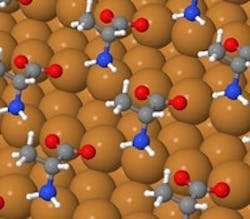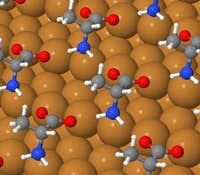Direct Production of Single Enantiomer Shapes Up
"Intrinsically chiral" metal surfaces lead to formation of a single enantiomer, report researchers at Cambridge University, Cambridge. U.K. They believe that enantioselective heterogeneous catalysis over such chiral surfaces might provide an attractive alternative to homogeneous catalysis and chiral separation techniques now used by industry. Such an approach would avoid issues of recovering homogeneous catalyst and separating enantiomers, the researchers explain. The chiral surfaces also could play a role in biosensors, they add.
A team headed by Stephen Driver of the university's department of chemistry created a chiral surface on copper and found that only one enantiomer of the simple amino acid alanine could form stable ordered structures on the metal (Figure 1). "It looks like alanine can shape a comfortable, chiral bonding site for itself. The copper surface has the flexibility to adapt itself to the shape of the alanine molecule, and this shape is different for the two different molecular enantiomers," he explains. A surface can be made for either enantiomer. Further details appear in a recent paper in Topics in Catalysis.
Because the surface is intrinsically chiral, it can be chemically cleaned without impairing its enantioselectivity, he notes.
The experiments have provided a "proof of principle" of the approach, which can be applied to other metals, as well, Driver says. Several key challenges remain.
"Matching the substrate to the molecule of interest is a key challenge. As with an enzyme, the shape of the bonding site is critical to the interaction, and the reactivity is also important," he notes.
"Surface orientation is crucial to the surface chirality. Cutting a macroscopic crystal to the desired orientation is fairly simple, but to get high surface area, it's likely that a means of fabricating supported nanoparticles at a controlled orientation will be needed."
In addition, the method may not suit production of larger molecules. "This approach relies on the chiral center of the molecule being in relatively close proximity to the surface, so there could be limitations on molecular size, and complications if the molecule contains multiple chiral centers. We plan to explore rather bigger molecules as part of our ongoing work, which will help to address this question. But large chiral structures are built out of small chiral building blocks, so this approach should certainly be helpful in terms of making these building blocks and also in performing at least some of the assembly into larger units."
Besides their use for synthesis such systems might serve in post-reaction purification steps, says Driver.
The researchers have just received a three-year grant for follow-up work. This will involve collaboration with Rutgers University, New Brunswick, N.J., which will run experiments on kinetics and dynamics. The Cambridge team will focus on structural and spectroscopic measurements as well as theoretical modeling.
The U.K. researchers also are actively exploring whether the chiral surfaces respond differently, perhaps in terms of surface stress and strain, to different enantiomers. If so, that could provide a basis for sensors, Driver notes.

